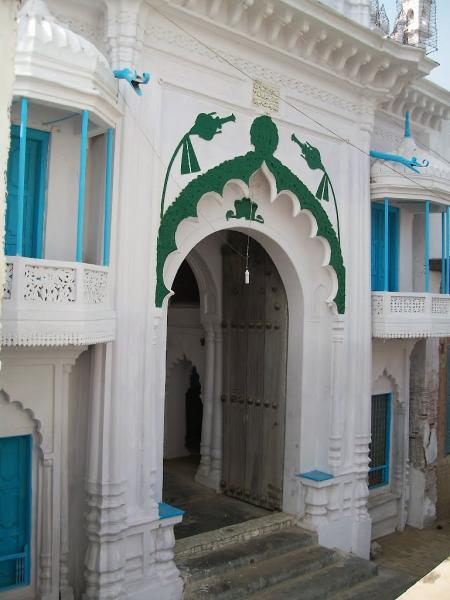
Main Entrance of Imambara Bari Sarkar,Zaidpur
Dr.Mazhar Naqvi
‘Bari
Sarkar’ is undoubtedly one of the oldest and well-maintained Imambaras with rare
holy relics. Located in North Indian town of Zaidpur, the foundation stone of
the existing structure was laid down by Late Meer Khadim Husain, the
Nazim-e-Umoor (commissioner) of Awadh Sarkar (Government) in 1223 Hijri (1808-1809).But
the history of eastern portion of Bari Sarkar dates back to the period of Zaidpur’s founder Late Syed Zaid Shahsawar. He was son of Syed
Abdullah, a direct descendant of the Prophet Mohammad through his daughter Hazrat
Fatima. He was scholarly and mystic figure and had earned the title of Zarbakhsh
(Gifter of gold) following his miraculous power to make gold fall from sky. Syed
Abdullah is believed to have arrived at Zaidpur
under instruction from Imam Rida in a dream around 460 Hijri (1069 A.D.) He later
married daughter of Salar Syed Daood who
had already settled down before the arrival of Zarbakhsh and ruling over the region. A child
named as Syed Zaid who born out of the marriage. After the birth, father-in-law
of Zarbakhsh got house for him constructed at Zaidpur along with the dwellings
for the accompanying 40 slaves, 40 she-slaves and a contingent of artisans and
people of different trades. Syed Zaid was also a brilliant scholar with saintly
habits. Out of his sheer love for progeny of the Holy Prophet, it is said that
he built an Imambara for mourning assemblies during Muharram. The old Imambara fallen
prey to vagary of weather sand caved in. When construction of Bari Sarkar was
decided, Mir Khadim covered portion of old Imambara as a part of his project.
Mir
Khadim spent lavishly on the construction of Bari Sarkar. A beautiful mosque
welcomes devotees in front of the main gate. He used Sang-e-Moosa (A very precious white and black
stone) for flooring. The area of Imambara is over 24000 SQFT. Two grand gates, opposite to each other
for exit and entrance, are situated east and north side of the complex and are
fine example of Rajasthani art. Apart from one large and four small ‘Shahnasheen’
( platform for keeping Tazia and Alams ), two big halls, a long platform with a
spacious courtyard with two symmetrical ‘Sahenchi’ (places for masses sitting) on
both sides form major part of Bari Sarkar. The Imambara is also famous as Deorhi
among locals.

Mosque Adjacent to Bari sarkar
The proud possessions of Bari Sarkar include a piece of ‘Fauladi Zareeh’ of Imam Husain, Brick of Hazrat Abbas’s Shrine, a piece of cloth from ‘Sardab’ (basement of Husain’s shrine), all collected from Karbala (Iraq) and 150 years old cover of Khan-e-Kaba (Mecca).The Alams of Imambara are made of gold, silver, copper and bronze. Alam of miracle, five stairs Mimber and a Zareeh made of silver , Dhal-Talwar (shield and sword), Tegh (A type of sword with on sharp blades both sides, are other attractions. Very costly chandeliers of glass and metals of Belgium and Turkey are also property of Imambara. The entire collection is nicely maintained and preserved as Tabarrukat-e-Aza (valuable and holy items of Aza).They are used for decorating Imambara during Muharram and devotees visit Bari Sarkar in large number to see them.
Another unique feature of Bari Sarkar is
absence of any architect in its construction. Mir Khadim conceived the design himself
after seeing Bara Imambara in Lucknow. He retained expert masons of Zaidpur and
Siddhaur to raise Imambara as visualized by him. He took personal care of the
construction to avoid any deviation from his imagination and plan. Awadh Government
had awarded him title of ‘Khan Bahadur’. His father Mir Nawazish Ali was also
holder of Das Hazari Mansab (post allowing him to keep ten thousand soldiers under
his command). The traditional Alam processions come to Bari Sarkar regularly up
to 8th of Muharram. A ‘langari’ (distribution of eatables as Tabarruk) majlis
takes place on 9th Muharram while Shahi Julus is taken out
Yaum-E-Ashura(10th Muharram). Chehlum of Imam Hussain is also
observed on 20th Safar with ‘Zuljenah’(Imam Hussain’s loyal horse)
being the biggest attraction. Bunyadiya Trust manages all the programs of Bari Sarkar
and make arrangements for devotees. The trust regularly organizes Mahfils,
Dasterkhwans and Majlises of Muharram and Chehlum. Janab Qamar Abbas, a native
of Zaidpur, reveals that Taluqedar Mir Aulad Hussain, son of Mir Khadim
had started processions on the street in his regime. Prior to him, Azadari was
confined to Imambara complex only. At a time when wakf properties are utterly
neglected and being ruined by corrupt Mutwallis in collusion with Wakf Board
officials, Bunyadiya Trust deserves praise for proper upkeep of not only structure
but also priceless relics. It is the efforts of trustees and their supporters
who are keeping intact Zaidpur’s image as a prominent center of Azadari with regal
touch.
(References:
1- Thesis titled ‘ The anthropology of
religion- Key-Contributions of People of Zaidpur to the Mourning Rituals.2-
Inputs given by Janab Qamar Abbas during conversation with blogger. He hails
from Zaidpur and supervises arrangements of Marasim-e-Azadari. Photo Courtesy
Google Images)
No comments:
Post a Comment